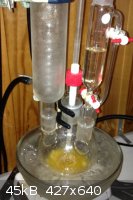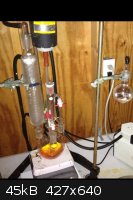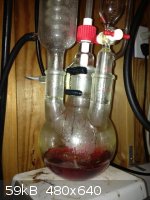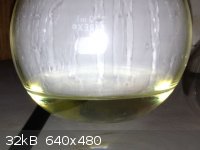
Ephesian - 24-10-2012 at 14:12
Part I. Benzodioxole Synthesis
In a 2L-round bottom flask with three necks equipped with reflux condenser, thermometer and mechanical stirrer was immersed in an oil bath. The flask
was charged with 100 mL of dichloromethane and 500 mL dimethylsulfoxide. Heat is then applied and 110 g of catechol and 85 g of NaOH are added in
portions through the wide bore condenser. The temperature gradually increased to 110-120 C during addition of catechol and NaOH. An additional 25 mL
of dichloromethane was squirted down the condenser to remove any particulate from the addition. The contents of the flask looked an amber green color
during and after addition, and at the end of the reaction ~30 minutes the temperature began to drop considerably even though heat was being applied.
The thermometer was then removed and the flask was set up for steam distillation. The azeotrope came over and separated leaving two phases, the lower
being benzodioxole. The product was transferred to a sep funnel and washed with 3 equal portions of water. And dried over anhydrous Na2SO4. Yield ~78
grams, 71% yield (not bad for a first time)
Note: you may extract the whole thing with DCM and wash with water, but I've read it isn't necessary and it saves extra solvent (even if you re use
it). Personally the final product looked great after the first water washing
Part II. 1,3-Benzodioxole-5-carbaldehyde synthesis
Vilsmeier-Haack reaction with thionyl chloride (US4157333) in production of piperonal.
------------------------------mass (g) M.W moles
N-Methylformanilide 86.328 135.16 0.638
Thionyl Chloride------75.988 118.97 0.638
Benzodioxole----------78 122.12 0.638
To a 4-neck round bottom flask equipped with a mechanical stirrer, thermometer with nitrogen inlet, condensor and addition funnel is charged with
86.32 g (.64 mole) of N-methylformanilide. Once inner temperature reaches <5 C on an ice water bath, 75.98 g thionyl chloride is added dropwise
over 1.5 hour period, not exceeding inner temperature >15 C. There were issues during thionyl chloride addition with crystallization of
N-methylformanilide when temperatures reached below ~8-10 C. With both addition of SOCl2 producing an exotherm and high agitation helped maintain a
uniform solution. After addition the reaction mixture was heated to room temperature and let stand for 2 hours. Heat was applied to approximately 45
C for 1 hour under reduced pressure to remove any excess unreacted thionyl chloride. Upon returning the mixture appeared orange in color. To the
resultant mixture, 78.00 g 1,2-methylenedioxybenzene was added dropwise into the reaction flask, while maintaining an inner temperature below 15 C.
After the addition the reaction mass appeared dark red in color, with a pungent smell that completely filled the entire room. The reaction mixture was
then poured into an equal volume of dH20 and extracted with 3X100 mL Toluene. The toluene was removed by distillation and under vacuum (pressure
unknown, KNF labport pump max 28.5 Hg) the bulk of the product came over between 145-149.6 C. This seems reasonable since the literature says the
product came over between 131-134 C at 10 mm Hg.
The final product has a very fruity, “cherry-like” odor that smells very similar to fragrances in liquid soap products. I plan on re-distilling
this product for purity as I am sure there is un-reacted benzodioxole in the mix. Shoot I'm not even sure if I got aldehyde, all I need to do is wait
and see if it has that characteristic stretch between 1800-1600 cm^-1 (aromatic aldehyde)
Notes and future experiments
1) Upon hydrolyzing your reaction product, make certain your pour your solution into water and not the other way around. Even though you removed
excess SOCl2 under reduced pressure there still may still be some there and it is HIGHLY reactive with water. Also there will be 1 equivalent of HCl
produced, and we all know add Acid to water.
2) I would like to consider use of a solvent during the thionyl chloride addition, I am heavily considering the use of Ethyl acetate
3) I am also considering adding a catalytic amount of DMAc to the mix to help catalyze the Vilsmeier-Haack reaction pathway. In the past I’ve always
done this with other VH reactions
4) I would also like to add the reaction mass to Benzodioxole instead.
Figure 1: During SOCl2 addition
Figure 2: Post SOCl2 addition
Figure 3: Post benzodioxole addition
Figure 4: Distillate




[Edited on 24-10-2012 by Ephesian]
[Edited on 25-10-2012 by Ephesian]
[Edited on 25-10-2012 by Ephesian]
DJF90 - 24-10-2012 at 21:59
Nice preparation... You're doing the reaction on a pretty large scale considering you said you're running through for the first time. Normally this
leads to wasting material due to unforseen problems but it looks like you were lucky this time. You don't provide a reference for the methylenation;
was this your own concoction? I've seen something similar before in the literature using alternate portionwise addition of sodium hydroxide and
catechol - JCS 1969 p1202.
As for the Vilsmeier-haack formylation, you mention problems associated with the N-methylformanilide. Perhaps replacing it with DMF, even
partially, would provide a more troublefree synthesis? I've heard mention of SOCl2 in the VH reaction, but this is the first time I've seen a picture,
so I thank you for that. Have you made provision for recycling the byproduct N-methylaniline back into the formanilide for future use? Theres
a nice paper using HCOOH and toluene with azeotropic water removal for making formamides.
And you've done the whole preparation without TLC? How did you know when consumption of the starting material was complete? Is there a tell-tale
visual observation that you went by?
I was suprised that when I saw this thread has no replies despite 60-odd views. I guess piperonal has this stigma attached to it. Its a shame really,
especially considering its really just an aldehyde. A friend of mine is independently investigating antibiotics, and lately he's taken a liking to
benzimidazoles. I bet piperonal and o-phenylenediamine would make a nice substrate for him, perhaps moreso if he nitrates the piperonal in
the 6-position first (giving 2-nitro-4,5-methylenedioxybenzaldehyde), as per JOC, 1985, 50, 5873 - 5875.
[Edited on 25-10-2012 by DJF90]
Magic Muzzlet - 25-10-2012 at 06:13
I like that you have presented this here but you have no yield!
If you need a cosolvent don't use EtOAc but use MeCN instead. Alternatively perhaps you can try forming the reagent in CH2Cl2, adding Et2O and
filtering under N2/Ar and then utilize the neat VH reagent, or in dry DMF.
I also think it would be highly beneficial for you to do this on much smaller scale, and figure out the ideal conditions, try purifying through the
bisulfite adduct even, and it will be highly beneficial to use TLC... Although I know it is a hassle since you need to work up a small portion each
time.. But this is quite an area of interest to many people and all you need to do to present VERY useful results is to do smaller scale reactions
with varying conditions.
I have wondered myself about modification of the classical VH for a few years now. I have tried a few substrates (mostly alkylthiobenzenes) with
(COCl)2 / N-methylformanilide or DMF but the results were negative.
Who can give more insight into the "type" of reagent that is formed with different acid chlorides with the DMF or other formamide??? This is so
unclear in literature, it sounds like phosgene, SOCl2, (COCl)2 can all be used, but the results are obviously different than with POCl3...
[Edited on 25-10-2012 by Magic Muzzlet]
mr.crow - 25-10-2012 at 07:14
Did you use nitrogen for the benzodioxole preparation?
DJF90 - 25-10-2012 at 07:18
This is the first paper I could find on the subject Magic.
[Edited on 25-10-2012 by DJF90]
Attachment: Chloromethyleneiminium salts.pdf (574kB)
This file has been downloaded 1656 times
Ephesian - 25-10-2012 at 09:26
@DJF90
Thank you, as for the Reference to methylenation:
Bonthrone, W; Cornforth, J.W. The Methylenation of Catechols. J. Chem. Soc. (1969), 1202-1204.
Followed this procedure, Except, I did not protect the vessel from atmospheric moisture, nor did I dry the solvents ahead of time. Instead of adding
water to the reaction mixture and distill off the azeotrope I set up the reaction flask for steam distillation.
I'll break out the TLC plates on the next run, it would be a great data point for sure.
______________________________________________
@Magic Muzzlet!
The problem I foresee with DMF is the fact that it will form the imidoylchloride which is a stable salt.1 This adduct is known as an
excellent chlorinating agent and I’m concerned that it will chlorinate one of the 4 accessible hydrogen on positions C-3, C-4, C-5, C-6 (however we
all know that C-4 and C-5 are the only that will take the halide).
1) J.S Pizey, Synthetic Reagents, Vol.1, John Wiley and Sons, New York, pp. 321-357
I’m sorry for not including the yield, as I said I am about to re-distill this product as I’m sure it contains unreacted benzodioxole. In addition
I would like to show the numbers of recovered benzodioxole to reacted forming piperonal. Shown in table II shows the relative yield of piperonal for
this reaction. For the 78 grams of benzodioxole used, visually I only obtained a 20-30% yield of what I consider an un-pure product.
I invoke that there is only one thing occurring here:
N-Alkylformanilide (methyl in this case) is forming N-methyl-N-phenyl-carbamic chloride:
Here is a reference from chem abstracts that suggests that formylating n-methyl-aniline with formic acid and chlorinating with phosgene to make
N-methyl-N-phenyl-carbamic chloride. (the same I invoke for SOCl2
Yiqing; J. Process for the preparation of N-(chloromethyl)-N-phenylcharbamoyl chloride from N-Methylaniline
Patent Information: CN101066937
Nov 7, 2007
Attachment: US4157333.pdf (1.1MB)
This file has been downloaded 1348 times
Attachment: V-Haack Piperonal Mechanism.pdf (32kB)
This file has been downloaded 906 times
[Edited on 25-10-2012 by Ephesian]
[Edited on 25-10-2012 by Ephesian]
popi - 5-11-2012 at 16:45
Great presentation!Yeilds will come as your on the right track.Purity is needed above yeilds.You say cherry smell. I say roses .Lovely!isn't
it?Rhodium agrees too.
